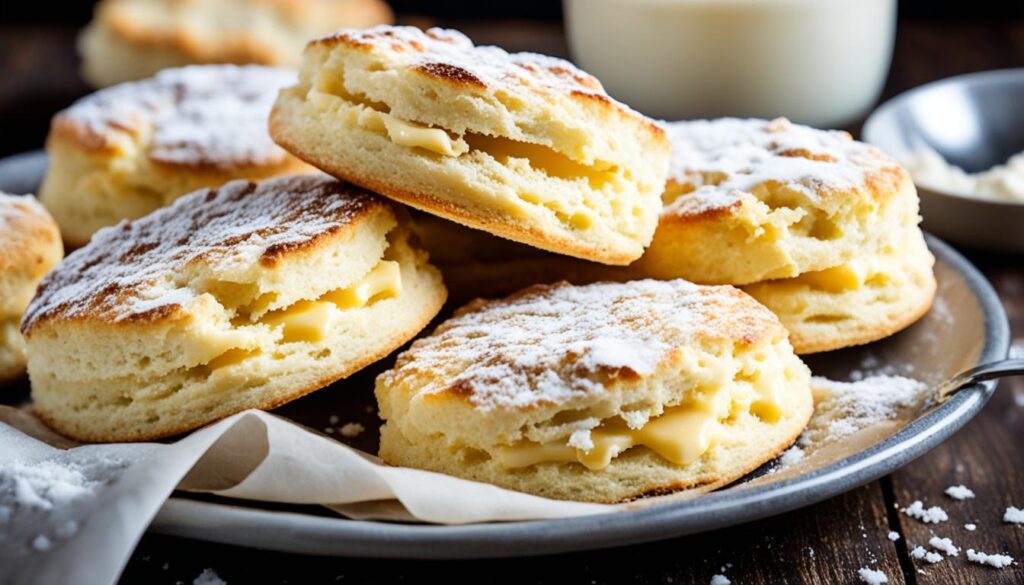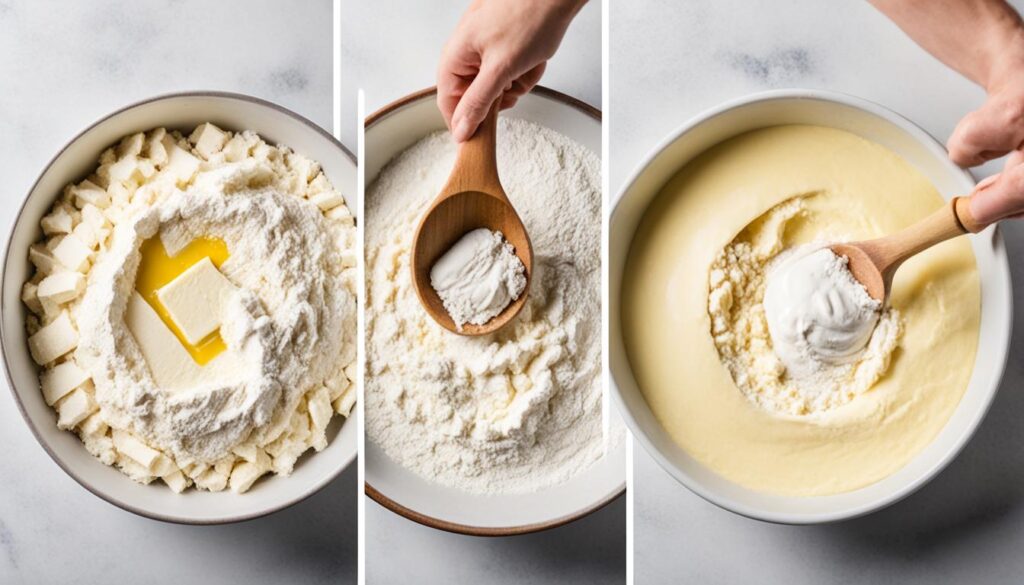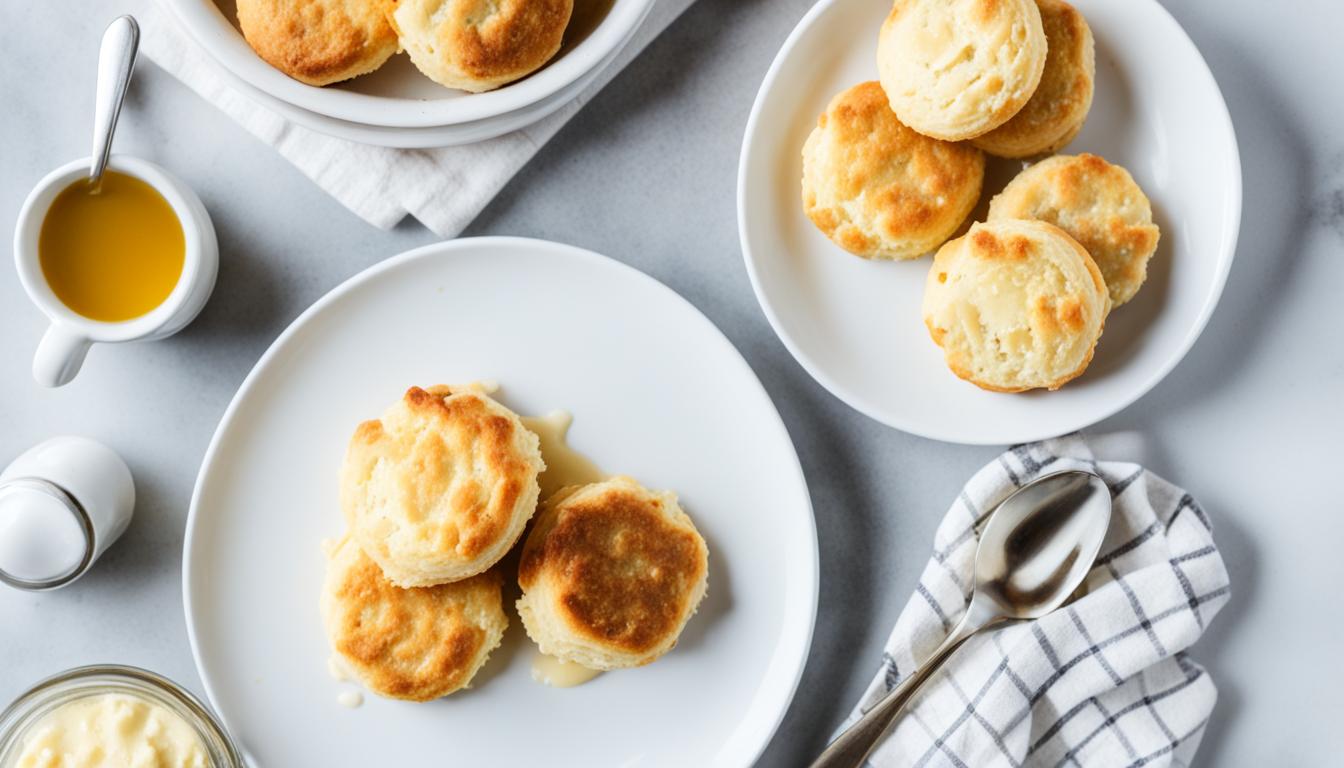Are you tired of trying countless biscuit recipes, only to be disappointed by lackluster results? Look no further! We have the ultimate recipe for perfect buttermilk biscuits – The Food Lab’s tried and tested method that guarantees tender and flaky biscuits every time.
With The Food Lab buttermilk biscuits recipe, you’ll discover the secrets to achieving biscuit perfection. This recipe incorporates innovative techniques and customizable flavors that will elevate your biscuit game to new heights. Get ready to amaze your friends and family with the best biscuits they’ve ever tasted!
Key Takeaways:
- The Food Lab buttermilk biscuits recipe is a reliable method for achieving tender and flaky biscuits.
- Techniques such as butter incorporation, folding the dough, and laminating create layers for a flaky texture.
- Customize your biscuits with flavors like cheese, scallions, bacon, black pepper, or honey.
- Understanding the science behind biscuit texture is crucial for achieving the desired result.
- Follow the tips and techniques in this article to elevate your biscuit baking game and enjoy the magic of homemade buttermilk biscuits.
The Science behind Flaky Biscuits
When it comes to achieving that perfect flaky texture in buttermilk biscuits, there is a scientific method behind the magic. Unlike pancakes, which have a uniform tenderness throughout, biscuits are made from a dough that has a high ratio of flour to liquid, allowing it to pull together into a cohesive ball.
The key to creating flakiness in biscuits lies in the way gluten forms and the incorporation of butter. As you mix your biscuit dough, the flour absorbs the liquid, and gluten strands start to form. Gluten is a protein network that gives structure and texture to baked goods. In biscuits, we want just enough gluten formation to hold the dough together, but not too much to make them tough or chewy.
The incorporation of cold and hard butter is crucial in achieving flaky layers. As the butter gets cut into the flour, it creates tiny pockets of butter coated in flour. These butter pockets help create distinct layers within the dough. When the dough is rolled and folded, these layers become thin sheets of gluten separated by layers of butter and butter-coated flour.
Let’s dive deeper into the science:
As the biscuits bake, the cold butter melts and creates steam. This steam helps create lift and separation between the layers of gluten, resulting in that sought-after flakiness.
In addition to butter, leavening agents like baking powder and baking soda play important roles in achieving the desired texture. Baking powder is a combination of an acid (often cream of tartar) and a base (usually baking soda). When these ingredients come into contact with moisture and heat, a chemical reaction occurs, producing carbon dioxide gas. This gas gets trapped within the dough, causing it to leaven and become lighter.
Proper technique is essential in biscuit-making to ensure a tender and flaky outcome. Avoid overmixing the dough, as this can lead to excess gluten formation and result in tough biscuits. Handle the dough gently, just until it comes together. Keeping all the ingredients cold is key to maintaining those distinct pockets of butter. Cold butter creates steam and pockets of air during baking, helping to create flaky layers.
The Food Lab buttermilk biscuits recipe incorporates all these scientific principles to give you the perfect balance of tenderness and flakiness. In the next section, we will explore the different varieties of buttermilk biscuits and how you can customize them to your liking.
| Ingredient | Amount |
|---|---|
| All-purpose flour | 2 ½ cups |
| Baking powder | 1 tablespoon |
| Baking soda | ½ teaspoon |
| Salt | 1 ½ teaspoons |
| Cold unsalted butter, sliced | 8 tablespoons |
| Buttermilk | 1 cup |
| Melted unsalted butter (for brushing) | 2 tablespoons |
The Different Varieties of Buttermilk Biscuits
Buttermilk biscuits come in various forms, each with its own unique characteristics. From chewy and crisp beaten biscuits to tender sweet potato biscuits, there is a wide range of flavors and textures to explore. Here are some popular variations of buttermilk biscuits:
- Beaten Biscuits: These biscuits are achieved by beating the dough for a long time to develop gluten structure. The result is a chewy and crisp biscuit.
- Sweet Potato Biscuits: Incorporating mashed sweet potatoes into the dough adds natural sweetness and maintains the biscuits’ fluffiness.
- Benne Seed Biscuits: These biscuits include sesame seeds, which can be incorporated whole or pounded into a powder. This gives them a crispy, cracker-like texture.
- Flaky Buttermilk Biscuits: These biscuits are rolled out, folded, and laminated to create peel-able layers, resulting in a flaky texture.
- Drop Biscuits: Made by dropping spoonfuls of dough onto a baking sheet, these biscuits have a crusty top and a tender interior.
- Cream Biscuits: Made simply with flour, baking powder, salt, and heavy cream, these biscuits have a tender crumb and rich flavor.
- Angel Biscuits: These biscuits use both baking powder and yeast to achieve a fluffy, bread-like texture.
- Skillet Biscuits: Cooked close together in a cast iron skillet, skillet biscuits have a crispy exterior and a soft interior.
If you’re looking to expand your biscuit repertoire, these variations offer a delightful twist on the classic buttermilk biscuit recipe. Try experimenting with different flavors and textures to find your favorite!
Comparison Table: Characteristics of Buttermilk Biscuit Varieties
| Biscuit Variety | Texture | Method | Flavor Profile |
|---|---|---|---|
| Beaten Biscuits | Chewy and crisp | Beating the dough to develop gluten structure | Neutral |
| Sweet Potato Biscuits | Tender and fluffy | Incorporating mashed sweet potatoes into the dough | Naturally sweet |
| Benne Seed Biscuits | Crispy and cracker-like | Including whole or powdered sesame seeds in the dough | Slightly nutty |
| Flaky Buttermilk Biscuits | Flaky and tender | Rolling, folding, and laminating the dough | Neutral |
| Drop Biscuits | Crusty top, tender interior | Dropping spoonfuls of dough onto a baking sheet | Neutral |
| Cream Biscuits | Tender and rich | Mixing flour, baking powder, salt, and heavy cream | Neutral |
| Angel Biscuits | Fluffy and bread-like | Using both baking powder and yeast in the dough | Neutral |
| Skillet Biscuits | Crispy exterior, soft interior | Cooking in a cast iron skillet | Neutral |
As you can see, each variety has its own unique texture, method of preparation, and flavor profile. Whether you prefer a chewy beaten biscuit or a tender sweet potato biscuit, the world of buttermilk biscuits offers something for every biscuit lover.
The Food Lab Buttermilk Biscuits Recipe
If you’re looking for a foolproof buttermilk biscuits recipe, The Food Lab has got you covered. With a few simple ingredients and some basic preparation steps, you can enjoy homemade buttermilk biscuits that are tender and flaky. Here’s what you’ll need:
- All-purpose flour
- Baking powder
- Baking soda
- Salt
- Unsalted butter (cold and sliced)
- Buttermilk
- Melted unsalted butter for brushing
To make the biscuits, follow these instructions:
- In a food processor, combine the dry ingredients – all-purpose flour, baking powder, baking soda, and salt. Mix until well combined.
- Add the cold and sliced unsalted butter to the food processor. Pulse the mixture until it resembles coarse meal.
- In a separate bowl, mix the buttermilk until well combined.
- Fold the buttermilk mixture into the flour mixture until just combined. Avoid overmixing.
- Transfer the dough onto a floured surface and knead it lightly. Roll out the dough into a rectangle.
- Fold the dough over itself and roll it out again. This step helps create flaky layers.
- Using a biscuit cutter, cut out the biscuits from the dough. Place them on a parchment-lined baking sheet.
- Brush the tops of the biscuits with melted unsalted butter.
- Bake the biscuits in a preheated oven until they are golden brown and well risen.
And there you have it – The Food Lab Buttermilk Biscuits recipe that will surely delight your taste buds. Serve them warm with butter or your favorite jam for a delicious breakfast or snack. Enjoy!

Tips for Perfect Buttermilk Biscuits
To achieve perfect buttermilk biscuits, we recommend following these key tips:
- Avoid overmixing the dough: Overmixing can lead to excess gluten formation, resulting in tough biscuits. Handle the dough gently and knead it just until it comes together.
- Keep all ingredients cold: Maintaining cold ingredients is crucial for creating distinct pockets of butter within the dough. This helps to achieve a varied and fluffy texture in the biscuits.
- Use a food processor: Incorporating cold butter into the flour can be done quickly and efficiently using a food processor. This prevents the butter from softening and ensures even distribution.
- Fold the dough over itself: Folding the dough multiple times creates additional flaky layers in the biscuits. This technique enhances the texture and adds lightness to the final product.
- Laminate the dough: For an extra boost of flakiness, you can also laminate the dough. This involves folding the dough into thirds and rolling it out again, similar to making puff pastry or croissants.
- Bake at a high temperature: To achieve a crisp exterior while keeping the interior light and tender, it’s important to bake the biscuits at a high temperature. This promotes rapid rising and browning.
By following these biscuit baking tips, you can enhance your buttermilk biscuits and achieve the perfect flaky texture. Take the time to incorporate these techniques into The Food Lab buttermilk biscuits recipe for a truly delightful biscuit experience.

Conclusion
Mastering the art of buttermilk biscuits requires practice and an understanding of the science and techniques involved. The Food Lab’s buttermilk biscuits recipe provides a reliable method for achieving tender and flaky biscuits, with the added option to experiment with various flavors. By following the tips and techniques outlined in this article, you can elevate your biscuit baking game and enjoy the magic of homemade buttermilk biscuits.
The Food Lab’s recipe incorporates scientific principles, such as the role of gluten formation and butter incorporation, to create biscuits with a perfect texture. Understanding how these ingredients and techniques work together is crucial in producing biscuits that are crisp on the outside and tender on the inside.
Furthermore, the world of buttermilk biscuits extends beyond the basic recipe. There are countless variations, such as sweet potato biscuits, benne seed biscuits, cream biscuits, and more, each with its own distinct characteristics. Exploring these different flavors and techniques can lead to unique and delicious results, allowing you to put your own creative stamp on the classic buttermilk biscuit.
So why not embark on a journey to discover the wonders of homemade buttermilk biscuits? With the guidance provided in this article, you have the tools to improve your biscuit baking skills, achieve flakiness and tenderness, and experience the joy of creating your own delicious biscuits from scratch. Get ready to delight your taste buds and impress family and friends with your newfound mastery of buttermilk biscuits!
